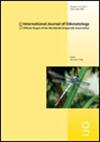蜻蜓的起始飞行距离具有物种特异性,与起始飞行距离呈正相关,有时与体长呈正相关
IF 1
4区 农林科学
Q3 ENTOMOLOGY
引用次数: 2
摘要
捕食者的逃脱行为是蜻蜓生活史的一个重要组成部分。飞行起始距离是逃逸开始的距离,在脊椎动物中研究得很好,在无脊椎动物中几乎没有研究,在蜻蜓中完全没有研究。在这里,我们测试了从脊椎动物研究中得出的关于飞行起始距离的四个原则,以检验它们是否适用于斯里兰卡的蜻蜓:(1)飞行起始距离是一种物种特有的特征;(2)飞行起始距离随着开始距离(实验者开始接近的距离)的增加而增加;(3)体型较大的个体有较长的起始飞行距离;(4)某些物种的起飞距离因性别而异。我们收集了11个物种的105个飞行起始距离(已知性别和大小)。不同物种间飞行起始距离不同,且与起始距离呈正相关。在三个数据丰富的物种中,有一个物种(n≥10)的起飞距离与体长呈正相关。在我们的样本中,起飞距离不随性别而变化。通过标准化的人类方法诱发的逃逸反应代表了一种富有成效的方法来研究野生蜻蜓的逃逸行为。本文章由计算机程序翻译,如有差异,请以英文原文为准。
Flight initiation distance in dragonflies is species-specific, positively related to starting distance and sometimes body length
Predator escape behaviour is a critical component of dragonfly life history. Flight initiation distance is the distance at which escape commences, and is well studied in vertebrates, barely studied in invertebrates, and entirely unstudied in dragonflies. Here we test four principles regarding flight initiation distance as derived from studies of vertebrates to examine if they apply to dragonflies in Sri Lanka: (1) flight initiation distance is a species-specific trait; (2) flight initiation distance increases with starting distance (the distance at which the experimenter begins an approach); (3) larger individuals have longer flight initiation distances; and (4) flight initiation distance varies between the sexes in some species. We collected 105 flight initiation distances from 11 species (known sex and size). Flight initiation distances varied between species and positively with starting distance. In one of three data-rich species (n ≥ 10), flight initiation distance was positively associated with body length. Flight initiation distance did not vary with sex in our sample. Escape responses evoked by standardised human approaches represent a fruitful methodology to study dragonfly escape behaviour in the wild.
求助全文
通过发布文献求助,成功后即可免费获取论文全文。
去求助
来源期刊

International Journal of Odonatology
ENTOMOLOGY-
CiteScore
2.30
自引率
0.00%
发文量
15
审稿时长
>12 weeks
期刊介绍:
International Journal of Odonatology (IJO) is aimed at providing a publication outlet for the growing number of students of Odonata. It will address subjects such as the ecology, ethology, physiology, genetics, taxonomy, phylogeny and geographic distribution of species. Reviews will be by invitation, but authors who plan to write a review on a subject of interest to the journal are encouraged to contact the editor.
 求助内容:
求助内容: 应助结果提醒方式:
应助结果提醒方式:


